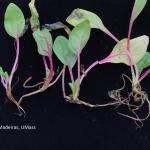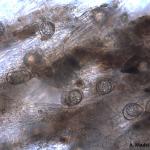Pythium root rot has been observed in several growing systems this spring. Pythium species tend to have broad host ranges and all greenhouse crops are susceptible to infection under the right circumstances. It is especially troublesome in overwatered or poorly drained growing media, and in hydroponic systems.
Symptoms of Pythium root rot include stunting, wilting, yellowed leaves, plant collapse, and death. It is always advisable to inspect the root system of plants with these symptoms. Infected roots will be brown and soft, sometimes with a “rat-tail” appearance as the outer cortex of the root sloughs off, leaving the vascular cylinder behind. Some species cause severe disease with a rapid onset, while others cause a chronic infection that progresses more slowly. Disease severity is also dependent on temperature, as the optimal range for growth and infection varies among species.
Pythium is not a “true fungus.“ It is an Oomycete or “water mold,” a group of organisms more closely related to algae. Most Pythium species spread by means of zoospores, mobile spores which have flagella (moveable tails) that allow them to swim through soil moisture. The zoospores are drawn to potential host plants by substances naturally produced by growing roots. The zoospore swims to the root and forms a cyst on the surface before proceeding to infect host tissue. It is easy to imagine how such an organism can flourish in moist soil or hydroponic systems.
Many Pythium species also form oospores, reproductive structures that may be seen in infected roots and are an important diagnostic feature under the microscope. These oospores have thick walls and are designed to resist adverse environmental conditions such as desiccation. In this way, Pythium can survive in contaminated soil and in hydroponic systems for a long time.
Sanitation is critical for successful Pythium management. Do not reuse potting media. Avoid re-using pots if possible; if pots are to be re-used, they must be thoroughly cleaned and all organic matter removed before treating with a disinfectant such as quaternary ammonium or 10% bleach. Similarly, all organic matter and biofilms must be removed from hydroponic systems prior to disinfection. Pythium also thrives when nitrogen is abundant, so excess fertilization should be avoided.
Because they are not true fungi, Pythium is not affected by most of the conventional fungicides used for pathogens such as Botrytis and Alternaria. Maneb and azoxystrobin are two exceptions to this rule. Most products available for Pythium prevention and management are specific either to the Oomycetes or to Pythium itself. Organic products have no curative qualities and must be utilized in a preventative manner. Several conventional and organic products are labeled for Pythium management: for a full list, please see the New England Greenhouse Management Guide.
For assistance in diagnosing and managing a suspected Pythium problem, consider submitting a sample to UMass Extension’s Plant Diagnostic Lab.
- Angela Madeiras, Extension Educator and Diagnostician, UMass Extension Plant Diagnostic Lab

